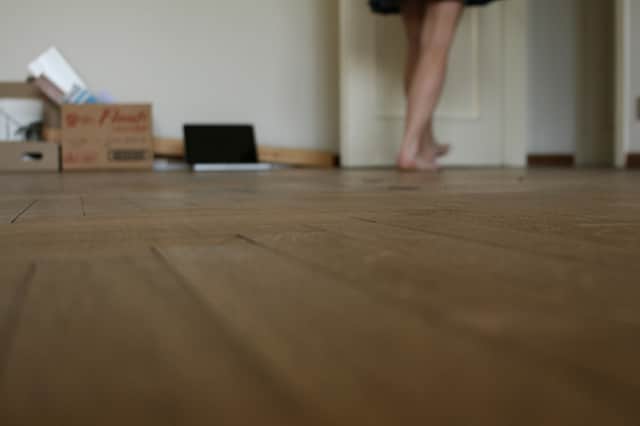[av_section min_height=” min_height_px=’500px’ padding=’default’ shadow=’no-shadow’ bottom_border=’no-border-styling’ scroll_down=” id=” color=’main_color’ custom_bg=” src=” attach=’scroll’ position=’top left’ repeat=’no-repeat’ video=” video_ratio=’16:9′ video_mobile_disabled=” overlay_enable=” overlay_opacity=’0.5′ overlay_color=” overlay_pattern=” overlay_custom_pattern=”]
[av_heading heading=’Lumber Buying Guide: A Comprehensive View of Softwoods’ tag=’h1′ style=” size=” subheading_active=” subheading_size=’15’ padding=’10’ color=” custom_font=” custom_class=”][/av_heading]
[av_textblock size=” font_color=” color=” custom_class=”]
Heading to the lumber yard to pick up some lumber for your project seems like a fairly straightforward mission. However, once you are there, ensuring that you are picking out the right type and quality of lumber you need for your project can be confusing. A quality lumber yard can help point you in the right direction, but it is helpful to have a basic understanding before you reach that point. To help gain that understanding, we have created this brief softwoods lumber buying guide. A basic overview of buying lumber can be found in our Lumber Buying Guide Overview, and more information is available on hardwoods and plywood in our Hardwood and Plywood Lumber Buying Guide.
[/av_textblock]
[av_two_third first min_height=” vertical_alignment=” space=” custom_margin=” margin=’0px’ padding=’0px’ border=” border_color=” radius=’0px’ background_color=” src=” background_position=’top left’ background_repeat=’no-repeat’ animation=” mobile_display=”]
[av_heading heading=’About Softwoods’ tag=’h2′ style=” size=” subheading_active=” subheading_size=’15’ padding=’10’ color=” custom_font=” custom_class=”][/av_heading]
[av_textblock size=” font_color=” color=” custom_class=”]
In an effort to help ensure that the proper lumber is used for a particular job, the US Department of Commerce developed the American Softwood Lumber Standard. This standard further breaks down softwoods into one of three categories which are Yard, Structural, and Shop and Factory.
[/av_textblock]
[/av_two_third][av_one_third min_height=” vertical_alignment=” space=” custom_margin=” margin=’0px’ padding=’0px’ border=” border_color=” radius=’0px’ background_color=” src=” background_position=’top left’ background_repeat=’no-repeat’ animation=” mobile_display=”]
[av_image src=’https://lumber-one.com/wp-content/uploads/2016/06/5649174310_3787e68dfa_z-300×200.jpg’ attachment=’1401′ attachment_size=’medium’ align=’center’ styling=” hover=” link=” target=” caption=” font_size=” appearance=” overlay_opacity=’0.4′ overlay_color=’#000000′ overlay_text_color=’#ffffff’ animation=’no-animation’ custom_class=”][/av_image]
[/av_one_third][av_heading heading=’Yard Lumber’ tag=’h2′ style=” size=” subheading_active=” subheading_size=’15’ padding=’10’ color=” custom_font=” custom_class=”][/av_heading]
[av_textblock size=” font_color=” color=” custom_class=”]
Yard lumber is generally graded visually, by looking at the wood and grading it on appearance. Based on how the lumber looks, it is further broken down into two categories called common and select. The terms are fairly self-explanatory. Common lumber is lumber that is not as visually appealing as select lumber, so it is primarily used for construction or utility purposes. Even common lumber is further broken down into three classes which are Nos. One, Two, and Three Common. No. One Common will be the best quality lumber having few knots that are tight and small, and is usually used for projects that are visible when finished. No. Two Common has larger knots and is often used for shelving and general woodworking. No. Three Common lumber has large knots and more of them. It will typically show damage and blemishes and is often used for applications such as fencing, pallets, and shipping crates.
Select Yard Lumber is much nicer looking than common lumber and is often used for projects that will have a natural or stained finish, or will be painted like furniture or trim. Select Yard Lumber is broken into two categories which are C Select and D Select. C Select lumber is the higher grade having very no defects while D Select will have very few knots no larger than the size of a dime.
[/av_textblock]
[av_heading heading=’Structural Lumber’ tag=’h2′ style=” size=” subheading_active=” subheading_size=’15’ padding=’10’ color=” custom_font=” custom_class=”][/av_heading]
[av_textblock size=” font_color=” color=” custom_class=”]
Structural Lumber is lumber most commonly used for construction and building projects. You know them as 2X4’s, 2X6’s, and other similar descriptions. This type of lumber comes in standard widths and thicknesses. However, they are sold in various lengths. The lumber is pre-cut which means less cutting is needed when working on a project. There are seven categories of Structural Lumber. We will not get into the details of each here, but they are classified by quality and strength similar to yard lumber.
The categories include Light Framing, which is further broken down into grades called Construction, Standard, and Utility. Structural Light Framing is the second category and is divided into classes called Select Structural, No. 1, No. 2, and No. 3. The third category is Studs, followed by a category named Structural Joists and Planks. These too are separated into classes of Select Structural One, Two, or Three. The fifth category is called Beams and Stringers with the same sub-classes. Posts and Timbers are the sixth category and are also sub-categorized as the others. The final category is that of Appearance Framing, which is the most visually appealing type of structural lumber. It is often used in siding and paneling and is categorized into one of three classes. These classes includes Supreme, Choice, and Quality.
It should also be noted that all species of Western softwoods are graded by select grading. The grades are A, B, C, or D. A is the most visually appealing grade while D is the least. However, even D Select lumber has only small pinholes or other minor blemishes.
[/av_textblock]
[av_heading heading=’Shop and Factory Lumber’ tag=’h2′ style=” size=” subheading_active=” subheading_size=’15’ padding=’10’ color=” custom_font=” custom_class=”][/av_heading]
[av_textblock size=” font_color=” color=” custom_class=”]
Lumber in this category is recommended for applications that are non-structural. This type of lumber is typically used for things like doors, wood boxes, ladders, and other remanufactured purposes. Lumber grades in this category are dependent on how the lumber will be used. For example, Shop and Factory Lumber used for doors will have a different grading system than lumber used for making ladders. However, the classification is usually based on the amount of quality lumber that can be taken from a piece of lumber for the use it is intended.
Choosing the right type of lumber can seem like a daunting task if you do not understand the options available. When you are at the lumber yard, don’t be afraid to ask the professionals for assistance. After all, lumber is their business, and most would be happy to help you navigate the different possibilities to find the best lumber to meet your needs.
Now that you understand the basics of softwood lumber, it is valuable to know the basic details in buying lumber, and the grading of hardwood and plywood lumber. Our Lumber Buying Guide Overview and Hardwood and Plywood Lumber Buying Guide provide the details you need to choose the perfect wood for your specific project.
[/av_textblock]
[av_heading heading=’Lumber One: Tough Bidders, Great Builders’ tag=’h2′ style=” size=” subheading_active=” subheading_size=’15’ padding=’10’ color=” custom_font=” custom_class=”][/av_heading]
[av_textblock size=” font_color=” color=” custom_class=”]
At Lumber One, your building project is our top concern. We operate with a focus on honesty and integrity in all we do and strive to deliver an exceptional experience for every client. We have comprehensive services from our full-service lumber yard to contracting and genuinely care about providing you with phenomenal service and attention. Since 1962, Lumber One has delivered this level of service and will continue to do so for the next generations as well. You can rest easy knowing that at Lumber One, we do things right the first time and never cut corners. Because of this, Lumber One is a leading expert in the Minnesota residential construction field. We invite you to contact us or visit one of our two locations. We are honored to serve you!
[/av_textblock]
[/av_section]

